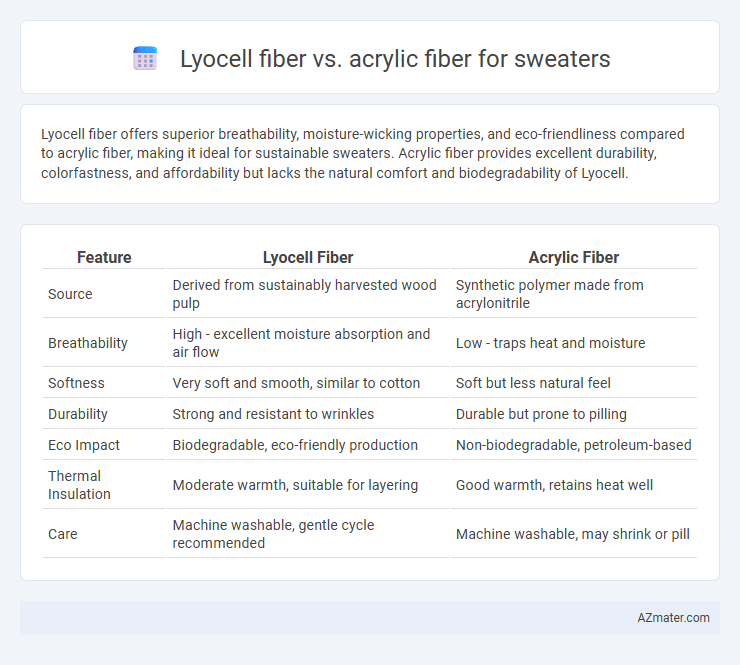Lyocell fiber offers superior breathability, moisture-wicking properties, and eco-friendliness compared to acrylic fiber, making it ideal for sustainable sweaters. Acrylic fiber provides excellent durability, colorfastness, and affordability but lacks the natural comfort and biodegradability of Lyocell.
Table of Comparison
| Feature | Lyocell Fiber | Acrylic Fiber |
|---|---|---|
| Source | Derived from sustainably harvested wood pulp | Synthetic polymer made from acrylonitrile |
| Breathability | High - excellent moisture absorption and air flow | Low - traps heat and moisture |
| Softness | Very soft and smooth, similar to cotton | Soft but less natural feel |
| Durability | Strong and resistant to wrinkles | Durable but prone to pilling |
| Eco Impact | Biodegradable, eco-friendly production | Non-biodegradable, petroleum-based |
| Thermal Insulation | Moderate warmth, suitable for layering | Good warmth, retains heat well |
| Care | Machine washable, gentle cycle recommended | Machine washable, may shrink or pill |
Introduction to Lyocell and Acrylic Fibers
Lyocell fiber is a sustainable, biodegradable fabric made from wood pulp using a closed-loop process, known for its softness, breathability, and moisture-wicking properties, making it ideal for sweaters. Acrylic fiber, a synthetic polymer derived from polyacrylonitrile, offers lightweight warmth, durability, and resistance to moths and chemicals but tends to lack the natural comfort and breathability of Lyocell. Sweaters made from Lyocell provide eco-friendly comfort with excellent moisture management, while acrylic sweaters prioritize affordability, easy care, and insulation.
Fiber Origin and Production Processes
Lyocell fiber, derived from sustainably sourced eucalyptus wood pulp, undergoes a closed-loop production process that uses non-toxic solvents, minimizing environmental impact and ensuring biodegradability. Acrylic fiber, a synthetic polymer made from polyacrylonitrile, is produced through a chemical-intensive process involving polymerization and extrusion, resulting in a non-biodegradable fiber with higher environmental costs. The natural origin and eco-friendly manufacturing of Lyocell contrast sharply with the petrochemical-based, energy-intensive production of acrylic fibers commonly used in sweaters.
Environmental Impact and Sustainability
Lyocell fiber, derived from sustainably managed eucalyptus trees through a closed-loop process, offers superior environmental benefits by minimizing water usage and chemical waste compared to acrylic fiber, which is petroleum-based and contributes to microplastic pollution. Lyocell is biodegradable and compostable, reducing landfill impact, whereas acrylic fibers persist in the environment for decades due to their synthetic nature. Choosing Lyocell for sweaters supports sustainable fashion by lowering carbon footprint and promoting resource-efficient production.
Comfort and Skin Sensitivity
Lyocell fiber offers superior moisture-wicking properties and breathability, making it highly comfortable and gentle on sensitive skin compared to acrylic fibers, which tend to trap heat and may cause irritation. The natural cellulose composition of lyocell enhances softness and reduces the risk of allergic reactions, whereas acrylic, a synthetic fiber, can sometimes provoke itching or discomfort for those with sensitive skin. Sweaters made with lyocell provide a hypoallergenic and breathable option ideal for prolonged wear, while acrylic fibers excel more in durability than comfort.
Moisture Management and Breathability
Lyocell fiber offers superior moisture management by efficiently absorbing and releasing moisture, keeping the skin dry and comfortable in sweaters. Its natural breathability enhances airflow, reducing heat retention and promoting a cooler wearing experience. Acrylic fiber, while lightweight, tends to trap moisture and heat, leading to less effective breathability and potential discomfort during extended wear.
Durability and Longevity
Lyocell fiber offers superior durability and longevity compared to acrylic fiber due to its natural cellulose-based structure, which resists pilling and maintains strength after multiple washes. Acrylic fiber tends to degrade faster under frequent wear, losing shape and softness over time due to its synthetic polymer composition. Sweaters made from lyocell provide enhanced lifespan and sustained appearance, making them a more durable choice for long-term use.
Warmth and Insulation Properties
Lyocell fiber offers moderate warmth and excellent moisture-wicking properties, making it breathable but less insulating than acrylic fiber. Acrylic fiber provides superior insulation and retains heat effectively, making it ideal for sweaters designed to keep warmth in colder temperatures. Choosing acrylic fiber enhances sweater warmth, while Lyocell improves comfort through breathability and moisture management.
Care and Maintenance Requirements
Lyocell fiber sweaters require gentle washing with mild detergent and should be air-dried to prevent shrinkage and maintain fabric softness. Acrylic fiber sweaters are more durable, machine washable, and resistant to wrinkles, but they may pill over time and benefit from gentle care to extend lifespan. Both fibers should be stored in a cool, dry place to avoid damage from moisture and insects.
Cost Comparison and Affordability
Lyocell fiber generally incurs higher production costs than acrylic due to its eco-friendly, closed-loop manufacturing process and sustainable raw materials, making sweaters made from Lyocell pricier. Acrylic fiber, derived from petroleum-based chemicals, is significantly more affordable and widely available, providing a cost-effective alternative for sweater production. Choosing between Lyocell and acrylic hinges on budget constraints and the value placed on sustainability versus low-cost apparel options.
Which Fiber is Best for Sweaters?
Lyocell fiber offers exceptional breathability and moisture-wicking properties, making sweaters comfortable and suitable for sensitive skin, while acrylic fiber provides durability, affordability, and excellent color retention. Sweaters made from Lyocell tend to be softer and more eco-friendly due to its sustainable manufacturing process, whereas acrylic excels in maintaining warmth and resilience after repeated washes. Choosing the best fiber depends on whether comfort and sustainability (Lyocell) or durability and cost-effectiveness (Acrylic) are prioritized for sweater production.

Infographic: Lyocell fiber vs Acrylic fiber for Sweater
 azmater.com
azmater.com